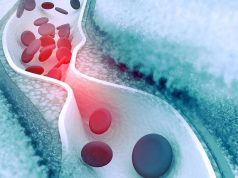Findings in patients with coronary artery disease on statin therapy after undergoing first PCI
TUESDAY, Sept. 15, 2015 (HealthDay News) — For patients with coronary artery disease (CAD) on statin therapy after undergoing a first percutaneous coronary intervention (PCI), the risk of all-cause mortality is increased with low high-density lipoprotein cholesterol (HDL-C) levels and elevated C-reactive protein (CRP), according to a study published in the Oct. 1 issue of The American Journal of Cardiology.
Manabu Ogita, M.D., Ph.D., from Juntendo University Shizuoka Hospital in Japan, and colleagues examined the impact of inflammation on the correlation between HDL-C and long-term outcomes in patients with CAD on statin therapy. A total of 3,507 consecutive patients with CAD who underwent a first PCI from 1997 to 2011 were enrolled. The 1,682 patients who had been treated with statins at the time of PCI were stratified into four groups according to HDL-C and CRP levels. Patients were followed for a median of 1,985 days.
The researchers found that 11.7 percent of patients died because of cardiac death, carcinoma, stroke, and other causes during follow-up. Among the groups, the rates of all-cause death varied significantly. Even after adjustment for other covariates, low HDL-C with high CRP levels remained significantly associated with a higher rate of all-cause death (hazard ratio, 2.38).
“Low HDL-C together with elevated CRP levels is significantly associated with long-term outcomes in patients who received statin therapy after PCI,” the authors write.
Copyright © 2015 HealthDay. All rights reserved.








